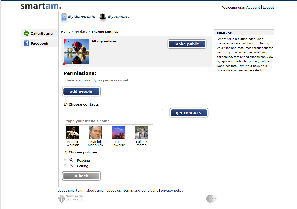Deployments
Apache Oltu library has been included in the following projects.
If you've developed an application using Apache Oltu and you want to be included here then let us know!
SMART Authorization Manager
SMARTAM v2.0 Beta is a user-managed authorisation manager for aggregating, sharing and protecting your online data. It allows you to register any kinds of Web resources (e.g. documents, photos, videos, etc) and share them with people from the contact list. As a user of the authorisation manager you can store various resources at different Web applications, in this version: Facebook, Picasa, and Gallerify.me!. Then, you can share these pictures by defining who can access them. All in one place, using a simple and friendly UI!
More Information
UMA/j Framework
This framework allows to build UMA-enabled Web applications. Interested? We'll host BoF and TiA sessions at Devoxx (Nov'10) or at MW4SOC (Dec'10). We also plan to be at IIW (Nov'10).
Checkout the SMART Project at Newcastle University and CCCS.
Gallerify.me
Gallerify.me is a fully OAuth 2.0 compliant Web application developed as part of the JISC-funded SMART Project at Newcastle University.
- OAuth 2.0 Client side
- OAuth 2.0 AS and RS
- Site-meta/Host-meta Discovery
- OAuth Dynamic Registration
Project Danube
Project Danube is an open-source project offering software for identity and personal data services on the Internet. The core of this project is an XDI-based Personal Data Store - a semantic database for your personal data, which always remains under your control. Applications on top of this database include the Federated Social Web, the selective sharing of personal data with organizations, and much more.
See the screencast how project Danube uses OAuth Leeloo here: Project Danube
Kiwi Project
Kiwi Project is a "Knowledge in a Wiki" project proposing a new approach to knowledge management that combines the wiki philosophy with the intelligence and methods of the Semantic Web. Technology-wise, the KiWi system is a component based architecture building on JBoss Seam and Java EE. The main principle is that everything is a content item, and that a content item always consists of human-readable content that is connected with RDF relations and may be annotated by users with semantic tags. This mixture allows content to be shared between applications: a content item that is created in the Wiki application can at the same time be displayed in TagIT as a location on the map or (later) as a blog post in the Blog application. This is made possible by the flexible structures offered by RDF. A particularly salient aspect of the KiWi core system is that it makes using RDF much more convenient for Java developers (no more manual triple store queries) by offering a flexible facading through interfaces annotated with special Java annotations that map Java methods to RDF properties.
